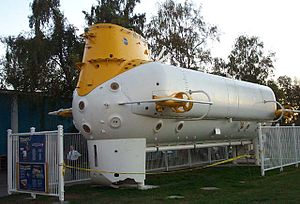- Ben Franklin (PX-15)
-

Career Name: Ben Franklin Namesake: Benjamin Franklin Builder: Grumman Laid down: 1966 Launched: 1968 In service: 1969 Out of service: 1971 Status: Museum ship General characteristics Type: Submersible Displacement: 130 long tons (132 t) Length: 48 ft 9 in (14.86 m) Beam: 21 ft 6 in (6.55 m) Height: 20 ft (6.1 m) Propulsion: 4 × electric motors, lead batteries Test depth: Crush depth: 4,000 ft (1,200 m) Crew: 6 Armament: None The Ben Franklin mesoscaphe[1], also known as the Grumman/Piccard PX-15, was a manned underwater submersible built in 1968. It was the brainchild of explorer and inventor Jacques Piccard. The research vessel was designed to house a six-man crew for up to 30 days of oceanographic study in the depths of the Gulf Stream. NASA became involved, seeing this as an opportunity to study the effects of long-term, continuous close confinement, a useful simulation of long space flights.
The Ben Franklin was built between 1966 and 1968 at the Giovanola fabrication plant in Monthey, Switzerland by Piccard and the Grumman Aircraft Engineering Corporation, then disassembled and shipped to Florida. The vessel is the first submarine to be built to American Bureau of Shipping (ABS) standards. With a design crush depth of 4000 feet (1220 m), it was designed to drift along at neutral buoyancy at depths between 600 and 2000 feet (180–610 m). The 130-ton ship has four external electric propulsion pods, primarily used for attitude trimming. It is powered by tons of lead batteries stored outside the hull. Its length is 48 feet 9 inches (14.9 m), with a beam of 21 feet 6 inches (6.6 m) and a height of 20 feet (6.1 m). Piccard insisted on 29 observation portholes, despite the objections of engineers over the inclusion of potentially fatal weak points.
It began its voyage on July 14, 1969, off Palm Beach, Florida, with Piccard as the mission leader. Accompanied by surface support vessels, it resurfaced on August 14, 1,444 miles (2,324 km) away, 300 miles (480 km) south of Halifax, Nova Scotia, Canada. Ben Franklin made a few more dives after 1969, including the first deep-sea dive for Dr. Robert Ballard, the discoverer of the wreck of the Titanic.
After running aground on a reef in 1971, Ben Franklin was sold to Vancouver businessman John Horton, only to languish for nearly three decades on the North Shore. In December 1999, with a sudden decision to either move or scrap the submersible, it was offered to the Vancouver Maritime Museum. After refurbishment the submersible was placed in front of the Museum.
Influence
Ambient artists Mathieu Ruhlmann and Celer collaboratively released an album called Mesoscaphe in 2008 dedicated to the voyage of the Ben Franklin.[2]
References
- ^ http://www.seemotive.de/html/tauch.htm
- ^ "Mesoscaphe". spekk.net. http://www.spekk.net/catalog/mesoscaphe.html. Retrieved 27 May 2010.
External links
- The Ben Franklin - Grumman/Piccard PX-15 Website
- From Sea to Shining Sea: A film treatment documenting the story of the Ben Franklin that was produced as a Discovery Channel Special
- Ben Franklin: Captain's Log
Coordinates: 49°16′39.9″N 123°8′51.8″W / 49.27775°N 123.147722°W
Categories:- Research submarines
- Human spaceflight analogs
- 1968 ships
- Individual ship or boat stubs
Wikimedia Foundation. 2010.

